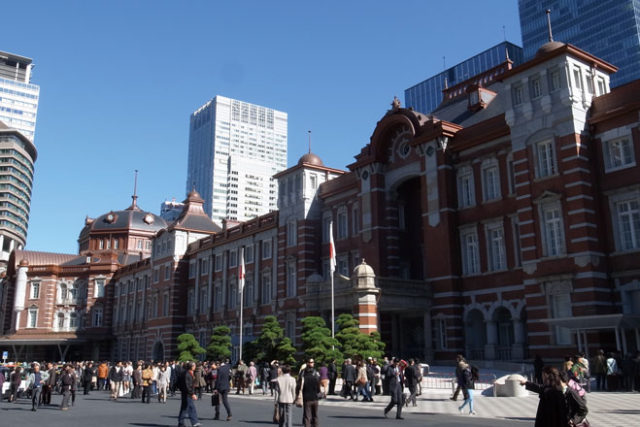By Yukiko Tanaka
For The North American Post
After two (or three, depending on the time you spend to have lunch or rest) days of walking in the Nihonbashi area to go as far as the Yaesu Exit of the Tokyo Central Station, you can now move to the station’s Marunouchi Exit. Walking the Palace compound and its surroundings, you can then go as far as Hibiya Park in a day.
You should have moved out of your first hotel and checked into another to stay for the next few to several days. Although there are many hotels in the area, all are in prohibitive price range. My recommendation, considering that your next visit is Asakusa and Ueno, is to find one in Asakusa-bashi, which can be reached by both JR and subway lines (two stops on the subway from Ningyocho).
The Marunouchi Exit was the front of Tokyo Central when the station was built in 1914, but after awhile the other exit has developed more rapidly. The situation has changed since, however, and today it has taken back its place as the front of the station. Most of the office buildings there are new, built with a more contemporary design, which is appealing to our eyes. The station itself, on the other hand, has gone through a complete restoration, and what you see now is exactly the way it was when it was built in 1914. One of the earliest of Japan’s western-style architecture is, I heard, in “Queen Ann style” modeled after the Amsterdam Central Station. The architect, Tatsuno Kingo, is a student of Josaiah Condor, a British architect who built several important buildings and mansions during the Meiji era. The restoration work was so good that it revealed original details and beauty that people from near and far have come to admire, making the station a sightseeing spot for a while.
There is a hotel inside the station compound, aptly named Station Hotel. It is equally old and went through a major repair of the roof, damaged by the 1945 fire bombings. You see a part of this hotel (prior to the recent work of restoration) in the wedding reception scene of Ozu Yasujiro’s 1958 film, “Equinox Flower.” In those days, the newlyweds who held receptions at this hotel were not a small number. They would then leave for their honeymoon from the Tokyo Central Station, often heading to Izu resort area.
Exit the station and you are in Marunouchi. Across the station plaza were, and still are, corporate office buildings. US Occupation Forces occupied some of the buildings here after the war. In one of those further toward the palace moat, General MacArther had his headquarters. That is, as someone described, he spent his days looking from his windows at the palace compound that accommodates the residence of the Showa Emperor (Hirohito).
It was Marunouchi, instead of Nihonbashi, that had become the heart of financial and managerial activity in the new era of Meiji, and it is so today. The Mitsubishi Corp. built most of the buildings here, originally in bricks, and it was thus called “London Town.” Having escaped the fire bombings during the Pacific War, these were nonetheless all torn down in order to make more office space save for one that is called the Mitsubishi No. One Building. It stands there today in its original bricks. The interior of the building is kept the same with the addition of a café created out of a previous office room. There is an art museum as well.
I remember the time when maru-biru (Marunouchi Buildings) stood in the station plaza; after a long stretch of time, the spot now has a new face, and instead of grey, concrete buildings we now have many new buildings (along with the original Mitsubishi brick building), making the area look more attractive. Marunouchi has changed into an urban office-shopping center where people not only work but enjoy themselves in the evening, dining in fine restaurants, etc. If you want to stroll in this sophisticated, new urban spot, my recommendation is to walk through Marunouchi Naka-dori.
[Editor’s Note]
This series will be published every week. The writer can be reached atytanaka03@gmail.com.







